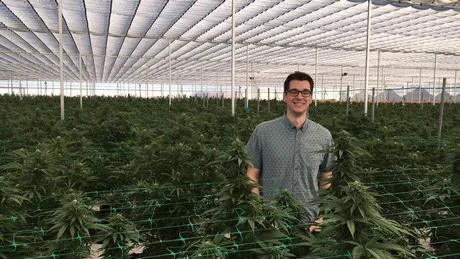In an ever-evolving cannabis industry, where things seem to change at the speed of light, the race to the bottom has been something that many growers have participated in but had hoped to avoid.
As cannabis prices continue to plunge, stakeholders are actively searching for ways to reduce their production cost either by growing in developing countries or moving crops back to outdoor production. “What matters at the production level is consistent replicable quality and cost, not branding” Richard Vollebregt, the President of Cravo explains. “So, everyone is trying to figure out how to grow to ensure their long term success. Many companies in Canada initially went for high-tech greenhouses; this decision being dictated by government regulators, essentially mandating that licensed producers grow in greenhouses or indoor environments. Subsequently the government legalized outdoor production which effectively drove some high tech glass houses to shut down or halt expansion and moving their production outdoors to lower their production costs. While this lowered the cost of production, it also exposed the huge challenges with weather extremes, contamination, pollination, extreme labour requirements for the harvest and then insufficient drying capacity”
Cannabis vs Tomato
Richard then pointed out an interesting comparison between the tomato industry and the cannabis industry. “By looking closely at how the tomato industry works, we can see exactly how the cannabis industry will evolve as it matures. In the fresh market for tomatoes, greenhouse growers must supply fresh tomatoes every week to the retailer. The price per kg is high and the tomatoes must look great but can often fall short in the flavour consumers typically find from a ripe field tomato. Tomatoes being grown in the open field for processing into tomato sauce or paste are all harvested at once and the producer is paid 90% less per kg than the producer of greenhouse tomatoes. Quite often a field grown tomato lacks the picture perfect appearance of greenhouse grown but is a champion for its superior flavour and long shelf life. So the question is whether cannabis producers should follow the high cost glass greenhouse model where the plants are grown and harvested year round through the hot summer and cold winter at a high cost of production, or whether they should grow in the lower cost and high profit open field model where there are one or two large harvests per year.”
But what if a cannabis producer could combine the advantages of growing outdoor and indoor while avoiding the limitations of each?
Well, Richard suggests that the industry considers in addition to current indoor, glasshouse and outdoor production systems, there is a fourth cultivation method. “The retractable roof production system,” he says. “This is a globally proven production system that allows crops to be grown outdoors but a roof will automatically closed whenever crops would benefit from protection or daylength control” It has been used for over 35 years on other crops like vegetables, berries and flowers and is now being used successfully for cannabis production. We used the knowledge and experience that we gained through our activity with these other crops and applied them to large-scale cannabis cultivation. Ultimately, we maintain our belief in the advantages of combining nature, crop protection and climate optimization, and cannabis quite frankly should be no different.
Protecting from Mother Nature
According to Richard, the retractable roof automatically helps outdoor growers to protect their crop from the dangers of Mother Nature. “You want to automatically protect your outdoor crops against extremes like chilling frost, hail, summer heat, heavy rains, strong winds and heavy dew conditions in the fall to reduce bud rot. You can increase the overall growth rates by ensuring that the climate stays within the optimal temperature range and light spectrum. Having the advantage of a retractable roof also helps protect crops against pollination and wind drift of chemical sprays coming from nearby farms. If you can automatically close the roof during strong winds, you can dramatically impede unwanted pollen and the chemicals from contaminating the plant. By excluding sunlight and making the roof black, growers now have control to regulate the flowering and harvest timing which then takes pressure of the high labour requirement for harvesting which then relieves the burden on drying capacity.
This is ultimately a very basic engineering approach, Richard remarks.
“What is the problem, and then how do you fix it without creating a new problem?
So, we asked ourselves what the challenges of outdoor cannabis cultivation are and addressed each of them to come up with a system that combines high quality and yield. Our job as we see it is to exploit the advantages of growing outside while eliminating the disadvantages. At the same time, I don’t think that glasshouses are to be disregarded completely: I think they will mainly produce cannabis for the ‘true specialty’ market; but when it comes to mass production of quality product, there isn’t anything more low cost than outdoor growing.”
 Kirk Schmitz, cannabis grower
Kirk Schmitz, cannabis grower
Clearly it is evident when it comes to mass cannabis production, Richard believes that the combination of outdoor cropping with retractable roof systems will be the go-to approach for having high quality with reliable yields at the lowest cost and with a reasonable capital investment and the risk avoidance that investors demand. “We have created financial models which compare production between growing indoors, in glass houses, outdoors and under 3 different retractable roof production systems and the numbers speak for themselves. For example, if you build a one-hectare glasshouse to grow cannabis, you may invest US$5M plus have to spend hundreds of thousands of dollars to operate the house. On the other hand, for the same $5M, you could construct anywhere from 2.5 to 7 hectares of automatic retractable roofs over your outdoor crop with virtually no yearly cost for heating or electricity for lights. These financial models will help growers targeting medical, flower or extract forecast how competitive their business will be in the future and how this 4th production system will help reshape cannabis production globally.
For more information:
Cravo Equipment Ltd
Phone: +(1) 519 759 8226 x 215
richardv@cravo.com
cravo.com
